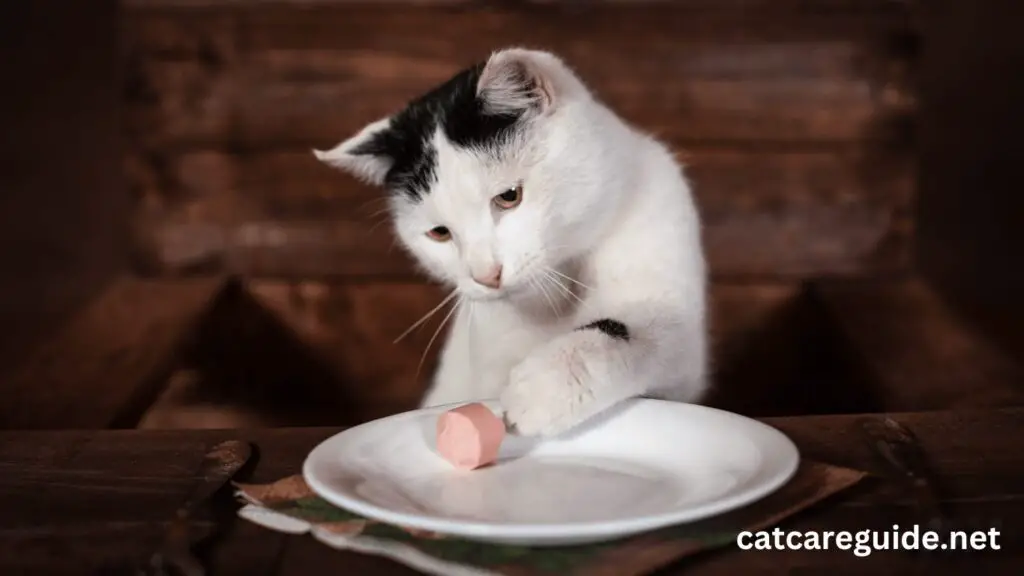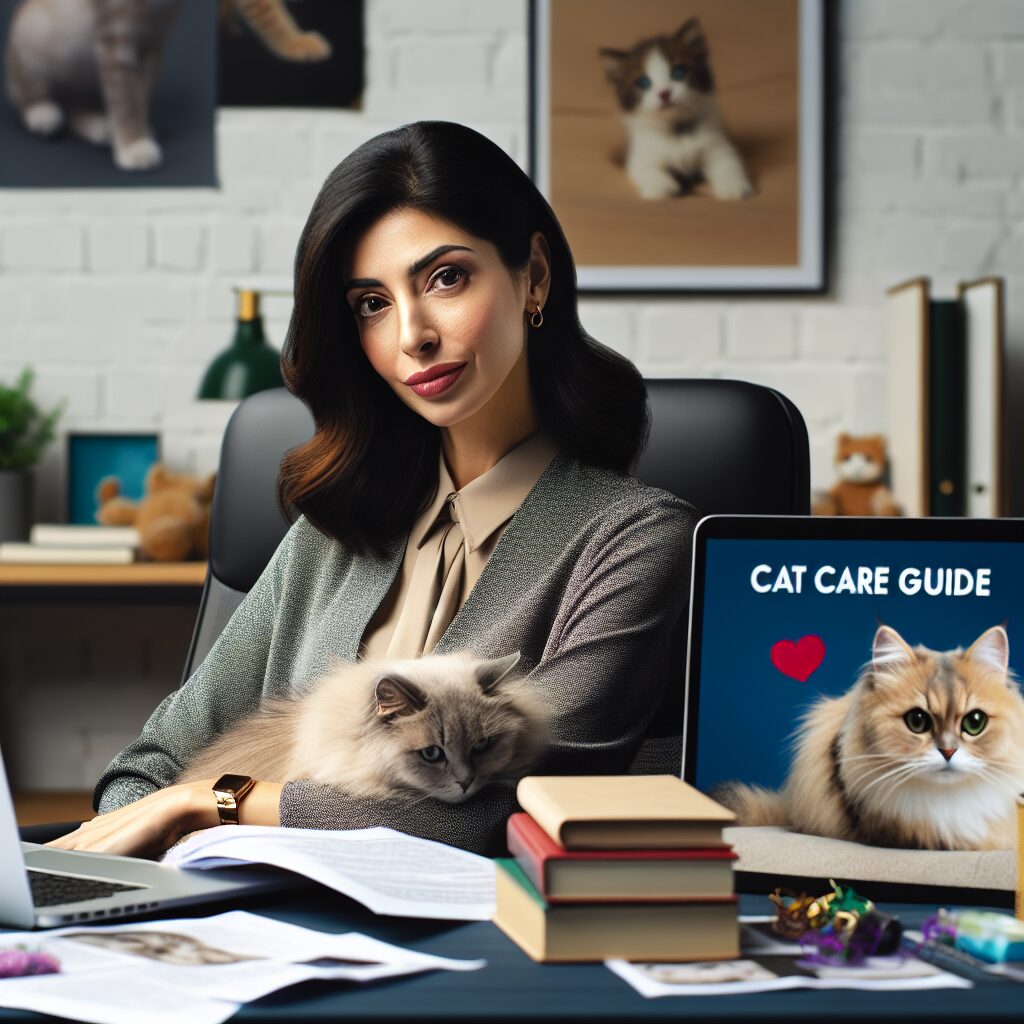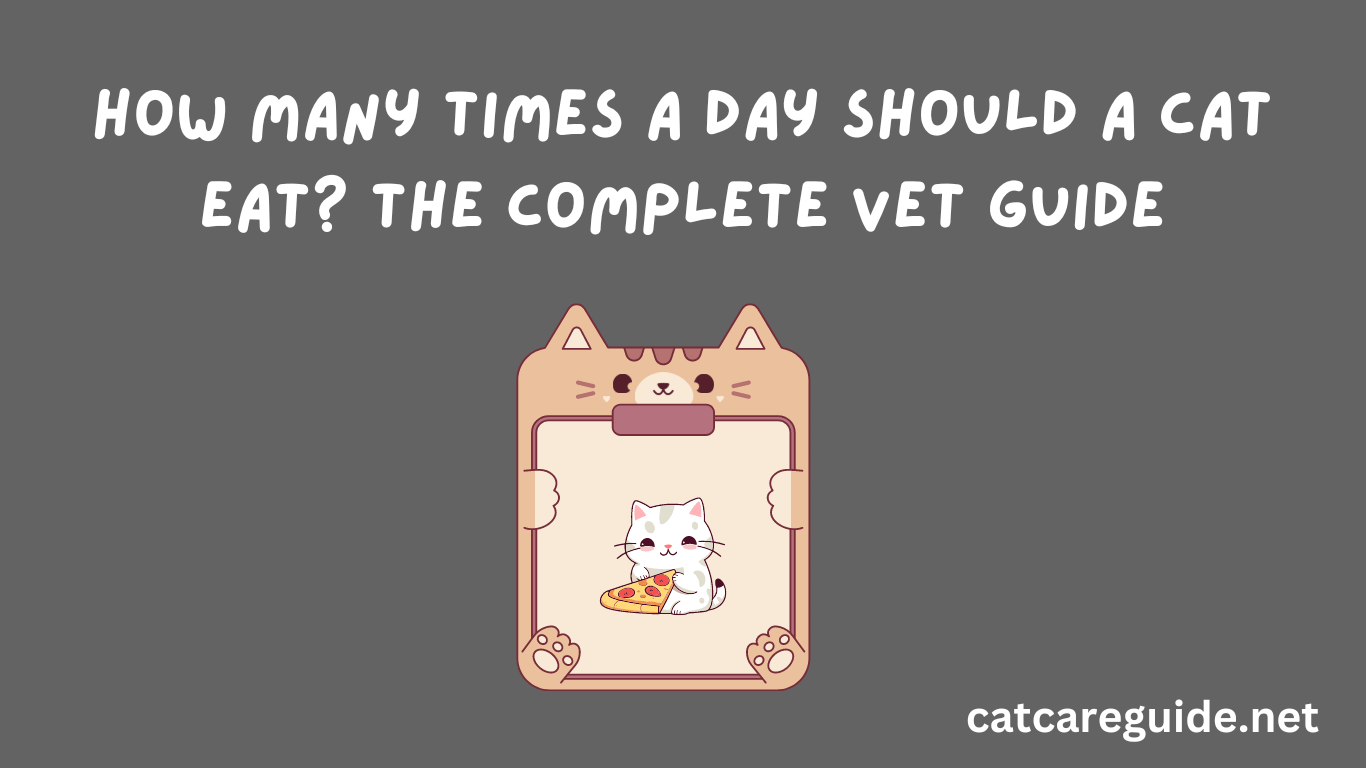How Many Times a Day Should a Cat Eat? The Complete Vet Guide
As a responsible cat owner, you want to provide the optimal diet for your furry friend. But with so much conflicting cat feeding advice circulating, how do you know what’s best? Cats have unique nutritional needs that vary based on age, activity level, and other factors. So there’s no one-size-fits-all approach to your cat’s dining schedule.
This definitive guide walks you through everything you need to know about crafting the perfect feline feeding plan. You’ll learn:
- Recommended daily feeding frequencies from kittenhood through senior years
- How much wet and dry food adult cats need
- Dangers of under or overfeeding your pet
- Signs your cat’s diet needs vet intervention
- Answers to the internet’s top cat feeding FAQs
Is Free-Feeding Recommended for Cats?
Free-feeding involves keeping your cat’s dry food bowl filled and available at all times for them to graze as desired. While this fits some felines, it also comes with health risks.
Here are the potential pros of free-feeding cats:
- Allows them to eat smaller meals whenever hungry
- No need to remember strict feeding times
- Provides constant access on your schedule
However, the downsides often outweigh benefits:
- Makes it harder to track how much your cat eats
- Can promote obesity and related illness
- Allows food to expire or get stale
- Enables territorial behavior around food
So what do veterinary experts advise? Most caution against free-feeding adult cats, but kittens may need round-the-clock access while rapidly growing.
As your cat ages, vets emphasize sticking to a consistent, measured feeding routine instead of always having food available. This helps ensure proper nutrition and weight control.
The Dangers of Free-Feeding Adult Cats
According to a study published in the Journal of Veterinary Internal Medicine, free-feeding can lead to obesity in cats. The study found that cats allowed to free-feed were more likely to be overweight or obese compared to cats fed on a set schedule.
Obesity in cats is a serious concern, as it can lead to various health problems, including:
- Diabetes: Obese cats are at a higher risk of developing diabetes, a condition where the body cannot properly regulate blood sugar levels.
- Arthritis: Excess weight puts additional strain on a cat’s joints, increasing the risk of developing arthritis and other joint problems.
- Respiratory Issues: Obesity can cause breathing difficulties and respiratory problems in cats, as excess weight can put pressure on their lungs and airways.
- Skin Problems: Overweight cats may have difficulty grooming themselves properly, leading to skin issues such as matted fur and skin infections.
Additionally, free-feeding can make it harder to monitor your cat’s food intake and detect potential health issues. If your cat is eating too much or too little, it may be an indication of an underlying medical condition that requires veterinary attention.
Kitten Feeding Schedule Guidelines
Kittens grow incredibly fast, nearly tripling their birth weight within a month. To fuel all this growth, they need more frequent feedings than adult cats.
Here are vets’ top tips on feeding kittens ages 4-12 weeks:
- Feed every 4-6 hours: Kittens should eat 3-4 times per day. Space feedings evenly.
- Provide wet and dry food: Mix canned kitten food with dry kibble for balanced nutrition.
- Follow portion guidelines: Kittens need roughly 4-6 oz or 120-180 calories daily. Follow label instructions.
- Transition gradually: Slowly incorporate new foods over 5-7 days when switching diets.
- Free-feed dry kibble: Keep dry food available so kittens can supplement between wet feedings.
- Clean dishes promptly: Discard wet food after 30 minutes to prevent spoilage.
Monitor your kitten’s weight weekly. Adjust portions if they become overweight or underweight.
The Importance of Proper Kitten Nutrition
Providing proper nutrition during the kitten stage is crucial for their overall development and long-term health. According to the American Association of Feline Practitioners (AAFP), kittens have higher energy and protein requirements compared to adult cats.
Kittens fed an inadequate diet during this critical growth period may experience:
- Stunted Growth: Insufficient nutrients can lead to a failure to reach their full adult size and weight.
- Weakened Immune System: A lack of essential vitamins and minerals can compromise a kitten’s immune system, making them more susceptible to infections and diseases.
- Developmental Issues: Improper nutrition can affect a kitten’s physical and cognitive development, potentially leading to behavioral problems or learning difficulties.
By following the recommended feeding schedule and providing a balanced diet with wet and dry food, you can ensure your kitten receives the necessary nutrients for proper growth and development.
By 12 weeks, kittens should transition to adult cat feeding recommendations you’ll learn next. Speak with your veterinarian if you’re unsure when to switch schedules.
Adult Cat Feeding Schedules
Once cats reach maturity around age one, they require less frequent but still regimented daily feedings.
Veterinary nutritionists recommend adult cats eat at least two measured meals per day. More active or larger cats may need three smaller servings.
Here are key considerations when developing an adult cat feeding schedule:
- Stick to consistent times: Feed roughly 12 hours apart, like breakfast and dinner.
- Determine wet vs dry ratios: Feed half wet food and half dry kibble for balanced nutrition.
- Portion controlled: Feed fixed amounts based on weight, activity level, age, etc. Most adults need 4-10 oz total per day.
- Consider automatic feeders: These can dispense meals if you’ll be away at normal feeding times.
Additionally, factor in lifestyle needs of indoor vs outdoor and single vs multi-cat households when crafting the ideal feeding routine.
Veterinarians emphasize fixed portions and consistent timing as the healthiest approach for adult cats. This helps prevent obesity and related conditions.
The Benefits of Scheduled Feedings for Adult Cats
Establishing a consistent feeding schedule for your adult cat offers several benefits:
- Weight Management: Portion control and regular mealtimes help prevent overeating and maintain a healthy weight.
- Improved Digestion: Scheduled feedings allow your cat’s digestive system to work more efficiently, reducing the risk of digestive issues like vomiting or diarrhea.
- Predictable Elimination: Regular mealtimes can lead to more predictable litter box habits, making it easier to monitor your cat’s health and maintain a cleaner litter box.
- Reduced Stress: Cats thrive on routine, and a consistent feeding schedule can help reduce stress and anxiety levels.
According to a study published in the Journal of Feline Medicine and Surgery, cats fed on a scheduled routine were less likely to exhibit signs of stress, such as excessive grooming or aggression, compared to cats with an irregular feeding schedule.

Factors That Influence Feeding Amounts & Frequency
While adult cats generally thrive eating two portion-controlled meals per day, a variety of factors influence your cat’s unique caloric needs.
Elements that impact daily feeding quantities and frequency include:
- Age: Kittens and seniors need tailored nutrition.
- Weight: Heavier cats require more calories than smaller breeds.
- Activity Level: More active cats need greater fuel intake.
- Medical Conditions: Issues like diabetes affect diet.
- Lifestyle: Indoor vs. outdoor and multi-cat homes impact eating habits.
- Pregnancy/Nursing: Expectant and nursing cats have increased calorie needs.
That’s why monitoring your cat’s weight and health is essential for modifying feeding as needed over their lifespan.
Feeding Recommendations for Senior Cats
As cats age, their nutritional needs change. Senior cats, typically defined as cats over 7 years old, may require adjustments to their feeding schedule and diet composition.
According to the American Animal Hospital Association (AAHA), senior cats may benefit from:
- Smaller, More Frequent Meals: Older cats may have trouble eating larger meals due to potential dental issues or decreased appetite. Splitting their daily portion into three or four smaller meals can make it easier for them to consume enough calories.
- Higher Protein Levels: Senior cats may require more protein to maintain muscle mass and support their overall health.
- Increased Moisture Content: Dehydration is a common concern in older cats, so a diet with higher moisture content (e.g., wet food) can help ensure proper hydration.
It’s essential to consult with your veterinarian to develop a suitable feeding plan for your senior cat, as individual needs may vary based on their specific health conditions and activity levels.
Signs Your Cat Is Over or Underfed
With an appropriate feeding schedule tailored to your cat, they should maintain a healthy weight and exhibit normal energy levels.
But if you notice any of the following symptoms, your cat’s diet likely needs adjustment:
Signs of Overfeeding/Obesity
- Noticeable weight gain
- Lethargy/moving less
- Difficulty cleaning coat
- Labored/heavy breathing
- Increased sleeping
Signs of Underfeeding
- Significant weight loss
- Extreme hunger/crying for food
- Loss of muscle mass
- Vomiting/diarrhea
- Increased anxiety/irritability
Addressing obesity or malnutrition early improves your cat’s long-term prognosis. Left untreated, these conditions can cause diabetes, arthritis, heart disease, and even premature death.
The Importance of Maintaining a Healthy Weight
According to the Association for Pet Obesity Prevention (APOP), approximately 59% of cats in the United States are overweight or obese. This staggering statistic highlights the importance of maintaining a healthy weight for your feline companion.
Obesity in cats is associated with a higher risk of developing various health issues, including:
- Diabetes: Obese cats are up to four times more likely to develop diabetes than cats of a healthy weight, according to a study published in the Journal of Veterinary Internal Medicine.
- Osteoarthritis: Excess weight puts additional strain on a cat’s joints, increasing the risk of developing osteoarthritis, a painful joint condition.
- Respiratory Problems: Obese cats may experience breathing difficulties due to the extra weight putting pressure on their lungs and airways.
- Urinary Tract Diseases: Obesity has been linked to an increased risk of urinary tract diseases, such as feline lower urinary tract disease (FLUTD), in cats.
On the other hand, malnutrition and underfeeding can also have severe consequences for your cat’s health. Cats that don’t receive enough nutrients may experience:
- Weakened Immune System: Inadequate nutrition can compromise a cat’s immune system, making them more susceptible to infections and diseases.
- Muscle Wasting: Lack of protein and other essential nutrients can lead to muscle loss and weakness.
- Nutrient Deficiencies: Deficiencies in specific vitamins and minerals can cause a range of health issues, such as skin problems, reproductive issues, and neurological disorders.
By maintaining a healthy weight through proper feeding practices, you can help ensure your cat’s overall well-being and reduce the risk of various health problems.
If your cat shows any abnormal symptoms related to their diet, contact your vet promptly to get them back on track.
When To Call The Vet About Feeding Issues
While most healthy cats thrive following standard feeding guidelines for their age, some situations call for specialized veterinary support.
Contact your vet promptly if your cat exhibits any of the following feeding-related issues:
- Rapid weight loss or gain
- Loss of appetite lasting over 48 hours
- Excessive hunger, eating non-food items
- Digestive issues like vomiting or diarrhea
- Difficulty chewing or swallowing food
- Increased lethargy or inactivity
- Skin problems, dull coat, excessive shedding
Additionally, managing prescription cat food diets requires close partnership with your veterinarian. They’ll provide specialized nutrition advice for conditions like:
- Kidney disease
- Hyperthyroidism
- Diabetes
- Food allergies or intolerances
- Heart disease
- Cancer
In these situations, your vet will recommend therapeutic formulas to keep your cat healthy.
The Importance of Consulting a Veterinarian
Consulting with a licensed veterinarian is crucial when it comes to your cat’s dietary needs and feeding schedule. Veterinarians have extensive knowledge and expertise in feline nutrition, and they can provide personalized recommendations based on your cat’s age, breed, health status, and other factors.
According to the American Veterinary Medical Association (AVMA), regular veterinary visits are essential for maintaining your cat’s overall health and well-being. During these visits, your veterinarian can:
- Assess Your Cat’s Body Condition: By performing a physical examination and evaluating your cat’s body condition score (BCS), your vet can determine if your cat is at a healthy weight or if adjustments to their diet are necessary.
- Identify Potential Health Issues: Various medical conditions, such as kidney disease or diabetes, can impact your cat’s nutritional requirements. Your vet can diagnose these conditions and recommend appropriate dietary modifications.
- Provide Personalized Feeding Guidelines: Based on your cat’s specific needs, your veterinarian can recommend the appropriate type and amount of food, as well as the optimal feeding schedule.
- Monitor Progress: Regular follow-up visits allow your vet to monitor your cat’s weight, body condition, and overall health, making adjustments to the feeding plan as necessary.
By working closely with your veterinarian, you can ensure that your cat receives the proper nutrition throughout all life stages, promoting their overall health and well-being.
The Bottom Line on Cat Feeding Schedules
Developing the perfect cat feeding schedule requires balancing factors like age, activity level, health status, and lifestyle. While kittens and cats with certain conditions need more tailored approaches, most adult felines thrive eating two portion-controlled meals per day. For the average cat, focus on consistent timing, measured amounts, and offering both wet and dry food.
Monitoring your cat’s weight and energy levels is key to ensuring their diet supports health and longevity. Contact your vet promptly about abnormal symptoms related to nutrition.
With the right feeding routine guided by veterinary best practices, your feline companion can live their very best life!
Feeding FAQs Answered By Vets
How often should a 3-month-old kitten eat?
3-month-old kittens need 3-4 meals per day of wet and dry food. Feed every 4-6 hours based on their age and weight.
Is it okay to leave dry food out overnight?
No. Dry food left out spoils rapidly. Refrigerating overnight is safest, but discarding and replacing is healthiest.
Should I feed outdoor stray cats near my home?
Feeding outdoor strays supports the population. It’s better to trap-neuter-return or adopt needy cats. Offer shelter instead of food.
How do I get my underweight cat to gain weight?
Gradually transition underweight cats to a high-protein, calorie-dense diet under veterinary supervision. Rule out underlying illness for weight loss.
How often should I feed a 1-year-old cat?
One-year-old cats can eat adult cat diets of two portion-controlled meals daily. Feed half wet food, half dry.
Is it okay to feed cats table scraps or human food?
No. Human food can harm cats since they require specific nutrients like taurine. Avoid milk, garlic, onions, chocolate, raw meat, bones, and more.
For any additional questions on crafting the optimal feeding plan for your cat, consult your local veterinarian.

Saira is the lead writer behind Cat Care Guide, a blog focused on providing cat owners with authoritative advice on feline health, nutrition, behavior, and more. As a zoologist specializing in microbiology and a dedicated cat owner for over 10 years, Saira combines her formal education, extensive research, and firsthand experience caring for cats into deeply researched blog content you can trust.
When she’s not working on new articles for Cat Care Guide, you can find Saira continuing to self-educate on the latest cat health developments, doting on her own cats at home, or volunteering at the local animal shelter. With a true passion for cat care and welfare, Saira’s mission is to help fellow cat lovers nurture happy, healthy lives for their feline companions.
Please feel free to reach out to Saira with any questions about caring for your cat! If needed, contact via the website contact form.




